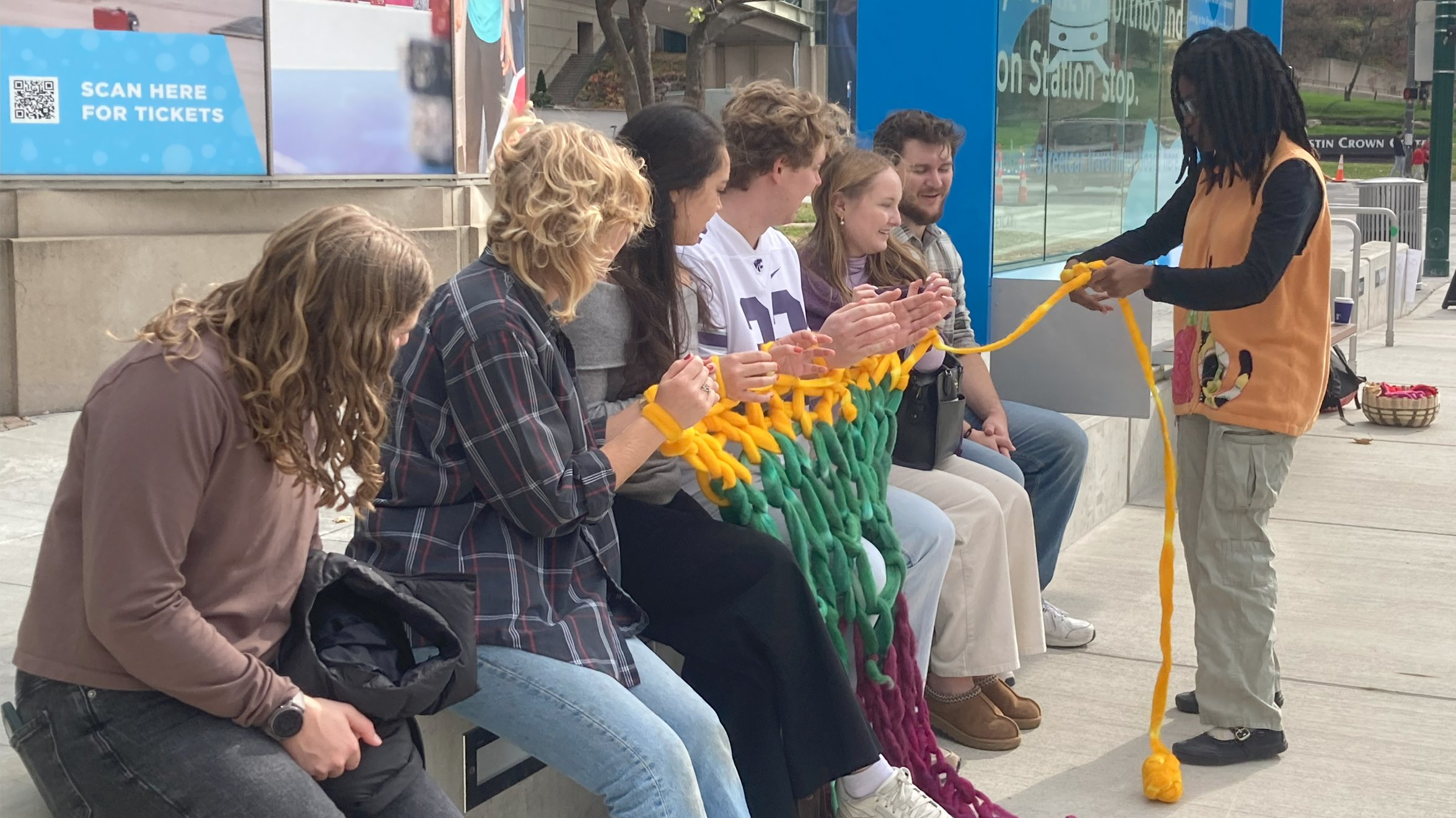
Cherline Philogene: Connecting Through Public Transit and Textiles
02.21.2025
Cherline Philogene (’25 Fiber & Social Practice) is using their senior capstone project to explore public transit and textiles as a means of fostering connection among commuters.
Through hands-on, accessible art activities, Philogene aims to break down the invisible social barriers on public transit and create meaningful interactions in a shared public space.
Commuter Community
Cherline Philogene has spent much of their life using public transit, relying on it to navigate daily life, from attending a magnet high school in Miami, Florida—where long commutes shaped their routine—to living off-campus in Kansas City without a car. Public transit has been a constant presence, something they value deeply, both as a practical necessity and as a shared, often overlooked social space.
Philogene’s senior capstone project in the Social Practice Program is an extension of this relationship with transit, a way to challenge the invisible barriers that exist between commuters.
“I take public transit every day. I see the same people multiple times, but we don’t really engage. The given is: you have your space, and I have mine. I wanted to break that notion,” Philogene said.
Finding Social Practice
Philogene first learned about social practice through Darcy Deal, KCAI’s Vice President of Enrollment Management. Like many first-year students, Philogene was eager to explore everything, declaring multiple interests. But it wasn’t until junior year that they took a class that solidified their understanding of the field.
“I knew early on that it was something my art fit into. What was really attractive about social practice to me was the way it centers people—you create a community,” they said.
Growing up in Florida as an “art kid,” Philogene was always participating in something creative—whether it was a month-long workshop or a one-day event, there was always someone organizing an opportunity for engagement.
“A part of me being an artist is realizing that I could be that person—the one facilitating these experiences for others,” they said.
A Project Rooted in Transit
Their project emerged from a Social Practice capstone class, where Philogene received a grant to realize a vision. Philogene knew they wanted to do something around public transit—a project that would engage people with textiles in a way that felt accessible and unintimidating.
“I heard it all the time—‘I’m not an artist.’ People are afraid of making something ‘wrong.’ I wanted to create a space where that fear didn’t exist,” they said.
Their Fiber professor, Pauline Verbeek, mentioned that she had previously done an exercise with Foundation students using long plastic party streamers. They would stand in a circle, wrapping the material between them to create a weave—an easy, hands-on activity designed to lower inhibitions and invite play. Inspired by this, Cherline thought about how they could adapt the concept to transit spaces.
Weaving People Together
On public transit, interactions are often unspoken. A familiar stranger becomes part of your routine—you recognize them, they recognize you—but rarely does that turn into direct engagement. Philogene wanted to create something physical, something visible, that both they and participants could look at and know: I was here. I made this with others.
“I think about dreams—how people in them are often just reimagined versions of faces we’ve seen in passing. Public transit is kind of like that. We overhear people’s stories, their jokes, their struggles, but we don’t acknowledge that we’re all part of the same moving space,” they said.
They set up at three different stops along the KC Streetcar: Union Station, City Market, and the Central Library. The timing of the project directly followed Election Day, and Philogene could feel something in the air—some people were stressed, others distant. Even so, many were open to the experience. Some hesitated, gripping the material tightly at first, but eventually, they relaxed.
“When the streetcar arrived, I would ‘free’ them, saying, ‘Okay, I’m releasing you now!’ And they would laugh,” they said.
The loops of wool—some messy, some tight, some carefully woven by hesitant hands—are physical traces of those small moments of connection.
“There’s this Peruvian system called quipu, where knots in a textile are used to record history. That’s what this feels like to me—a way to preserve fleeting interactions,” they said.
Material and Meaning
Cherline used merino wool roving for the project, a material they love for its softness and ability to hold rich color. They dyed some of it themself, while other pieces were purchased.
Beyond its physical qualities, wool holds deeper meaning for them. “We don’t often associate textiles with the animals they come from. But wool comes from sheep—it’s a living material. And we’ve commodified these creatures to the point that they need us now. We’ve bred them to grow so much wool that, without human intervention, they would literally suffocate.”
Pushing Past Shyness
Philogene describes themself as a shy person, someone who doesn’t naturally feel comfortable approaching strangers—a skill that is often required in Social Practice.
“At first, I was like, ‘Why did I put myself in this situation? But eventually, to overcome the shyness I felt, I just started pretending I was on an episode of Sesame Street,” they said.
They also knew that choosing the streetcar rather than the bus gave them a better chance of success. “The streetcar is more of a leisurely activity here—people are in a different mindset than on the bus. It gave me more wiggle room.”
Even so, there were challenges. Many people assumed Philogene was asking for money. “They’d say, ‘Oh, sorry, I can’t donate anything,’ before I even explained the project.” But once they reassured them, most were willing to participate.
For them, the project isn’t just about making something—it’s about disrupting the rhythms of everyday life in a way that invites play, vulnerability, and connection.
“When your hands are working, your mind is free. And when you’re free, you can be open to others,” they said.